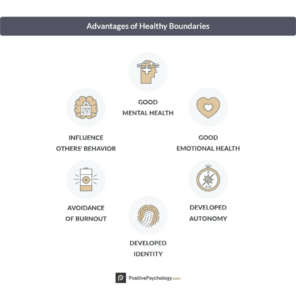One thing I have repeatedly noticed over this past year is just how many people are not fully or sometimes at all aware of the concept of healthy boundaries. Some believe they already have healthy boundaries by having super rigid brick walls in place, or they hold the belief that establishing boundaries would be a harsh and unkind act. However, setting and maintaining boundaries are a vital element to establishing one’s identity and is significant to achieving good mental and relational health. When boundaries are applied and we see evidence of them working, we feel it and see how it can do wonders for our well-being.

If I were to identify the purpose of boundaries in a super succinct nutshell, I could say that boundaries teach others how to treat us. But I feel that this important element of self-care warrants a more extensive exploration than this. To give some definition to the concept, boundaries occur when you can sense yourself and your needs in a situation and use your voice to express those needs to another. A boundary is a limit or space between you and another person. It is a clear space defining where you begin, and the other person ends.
Our boundaries may be loose or rigid with healthy boundaries laying somewhere in between these. Some people’s boundaries are non-existent which can signify that we lack an identity or that we are enmeshed with another person. Nevertheless, all of us have limits and without being proactive in caring for and protecting ourselves, these limits can be violated.

Having poor boundaries can result in feelings of stress, anger, burnout, disappointment, wasted time, financial burden, or relationship issues. These feelings, left to grow, can lead us to total cut off from another, or on the other hand, total enmeshment with someone where there is no distinct division between our and the other persons feelings and needs. When we don’t have healthy boundaries, our relationships cannot thrive. Nevertheless, the more we set boundaries, the easier it is to recognise them. Through healthy boundaries we assist others in showing up for us in a way that is respectful of our needs, and we become better at showing up for them in the same way.
With all this being said, what might healthy and unhealthy boundaries actually look like?
Healthy Boundaries:
Not discussing intimate topics of conversation with someone during a first meeting.
Putting your own values above any desire you may have to please others.
Talking to your partner about having one evening a week alone rather than spending all your evenings together.
Asking your friend who has dropped by unannounced at a busy time for you not to stay for too long.
Delegating house chores to your partner or house mates if you have taken on most of the load.
Declining a request to share your belongings with someone else and refusing to engage in an argument as to why.
Asking your parents to not read your diary or journal to maintain an element of privacy in your life.
Telling someone that you are not available to get together or chat by phone or text message if you are busy, having you time, or for any reason do not want to.
Blocking or asking someone to not send you messages with disturbing or sexual content.
Knowing that you have the right to your emotions and feelings.
Always know that “You are not required to set yourself on fire to keep others warm” – Penny Reid
Unhealthy Boundaries:
Allowing another to define you and act as the director or controller of your life.
Allowing your boss to provide you with your work schedule at short notice every week.
Being overwhelmed, obsessed, preoccupied, or falling in love with new acquaintances.
Providing a lot of self-disclosures to a someone you hardly know.
Saying yes to sex with anyone or your partner when you do not want to, or meeting another person’s demand for an explanation when you say no.
Allowing someone to use illegal substances or engage in criminal behaviour while in your company when you feel uncomfortable with it.
Not being accepting of when others say no.
Accepting food, gifts, or any physical contact that you do not want.
Sometimes we know exactly what we want, and just how disrespectful, uncomfortable or unjust something another is doing may be, but how do we protect ourselves?
Before anything, it is useful to remember, that when we set a boundary we let go of the outcome – our boundary must come first!
Here is a step by step for establishing a boundary:
- First, recognise what your need is/the boundary you want to establish
- Communicate clearly what it is you need to the other(s) involved
- Keep it simple – you do not have to over explain
- Set consequences and say why it’s important
- Stick to your word! This can be done by implementing those consequences if your boundary is disrespected.
(This last step can be especially important when there has been repeated boundary breaking or in those relationships where we have thought someone over time that it is okay to mistreat us.)
Remember, you do not need to make excuses for your right to have boundaries. For example, rather than saying “I can’t” do or allow something, it can be more effective to use the words “I don’t” or “I won’t” do or allow something. The use of these words is a way of letting someone know that this is a non-negotiable matter, and you stand strong in this aspect of what you do or allow.

Take home message:
Setting healthy boundaries are crucial in life and a vital part of having an effective self-care practice. Although it’s healthy to not be overly rigid with our boundaries, at the very least it’s important to authentically express our discontent when one is broken rather than pretend all is well. The reason why this is important is because when a boundary is broken in any type of relationship and we let it completely slide, it is not the end of a boundary breaking issue in that relationship, it is the start of one!
When a person is not used to establishing boundaries, it can be normal to feel guilty or selfish when starting out despite how this practice can be an important element to good mental health. Even though it is much easier to maintain boundaries with someone we have established them with from the start, it is never too late to set them with those we have already formed relationships with. In these cases, it may be helpful to be more assertive and stronger in your intention to pave a new way for how you are treated as implementing boundaries in these instances can be met with great resistance.
Not everyone may gladly welcome this change or the new you. But as the saying goes, “Those who matter don’t mind, and those who mind don’t matter”. Despite how challenging the resistance from another may be, teaching someone how to treat you can be so worth it for your own future within or without that relationship and can do wonders for your overall levels of happiness as well as your self-esteem. When establishing boundaries in relationships where these previously didn’t exist, assertion, consistency and sticking to your word are key. The first time is always the hardest, but with practice this can become easier and even natural over time as you begin to feel stronger in yourself and experience the benefits.
Finally, while setting boundaries for ourselves is an essential element to our well-being, it is just as important to respect the boundaries that those we interact with have set for themselves. This includes parents, children, romantic partners, friends, bosses, co-workers, and anyone we have an interaction with. We must appreciate the boundaries of those around us just as we do the maintenance of our own, as respect is a two-way street.
The article is written by Darina, Trainee Counsellor at The DMC Clinic. If you would like to discuss how any of the topics mentioned above are impacting your mental health, please contact The DMC Clinic to arrange an appointment.









